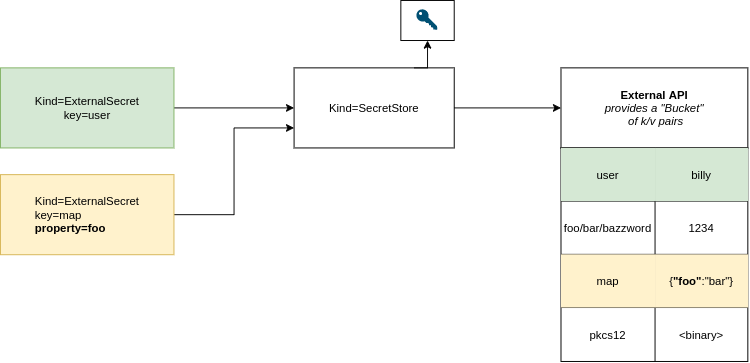4.3 KiB
API Overview
Architecture
The External Secrets Operator extends Kubernetes with Custom Resources, which define where secrets live and how to synchronize them. The controller fetches secrets from an external API and creates Kubernetes secrets. If the secret from the external API changes, the controller will reconcile the state in the cluster and update the secrets accordingly.
Resource model
To understand the mechanics of the operator let's start with the data model. The SecretStore references an bucket of key/value pairs. But because every external API is slightly different this bucket may be e.g. an instance of an Azure KeyVault or a AWS Secrets Manager in a certain AWS Account and region. Please take a look at the provider documentation to see what the Bucket actually maps to.
SecretStore
The idea behind the SecretStore resource is to separate concerns of authentication/access and the actual Secret and configuration needed for workloads. The ExternalSecret specifies what to fetch, the SecretStore specifies how to access. This resource is namespaced.
{% include 'basic-secret-store.yaml' %}
The SecretStore contains references to secrets which hold credentials to
access the external API.
ExternalSecret
An ExternalSecret declares what data to fetch. It has a reference to a
SecretStore which knows how to access that data. The controller uses that
ExternalSecret as a blueprint to create secrets.
{% include 'basic-external-secret.yaml' %}
ClusterSecretStore
The ClusterSecretStore is a global, cluster-wide SecretStore that can be referenced from all namespaces. You can use it to provide a central gateway to your secret provider.
Behavior
The External Secret Operator (ESO for brevity) reconciles ExternalSecrets in
the following manner:
- ESO uses
spec.secretStoreRefto find an appropriateSecretStore. If it doesn't exist or thespec.controllerfield doesn't match it won't further process this ExternalSecret. - ESO instanciates an external API client using the specified credentials from
the
SecretStorespec. - ESO fetches the secrets as requested by the
ExternalSecret, it will decode the secrets if required - ESO creates an
Kind=Secretbased on the template provided byExternalSecret.target.template. TheSecret.datacan be templated using the secret values from the external API. - ESO ensures that the secret values stay in sync with the external API
Roles and responsibilities
The External Secret Operator is designed to target the following persona:
- Cluster Operator: The cluster operator is responsible for setting up the External Secret Operator, managing access policies and creating ClusterSecretStores.
- Application developer: The Application developer is responsible for defining ExternalSecrets and the application configuration
Each persona will roughly map to a Kubernetes RBAC role. Depending on your environment these roles can map to a single user. Note: There is no Secret Operator that handles the lifecycle of the secret, this is out of the scope of ESO.
Access Control
The External Secrets Operator runs as a deployment in your cluster with elevated privileges. It will create/read/update secrets in all namespaces and has access to secrets stored in some external API. Ensure that the credentials you provide give ESO the least privilege necessary.
Design your SecretStore/ClusterSecretStore carefully! Be sure to restrict
access of application developers to read only certain
keys in a shared environment.
You should also consider using Kubernetes' admission control system (e.g. OPA or Kyverno) for fine-grained access control.
Running multiple Controller
You can run multiple controller within the cluster. One controller can be
limited to only process SecretStores with a predefined spec.controller
field.
!!! note "Testers welcome" This is not widely tested. Please help us test the setup and/or document use-cases.

